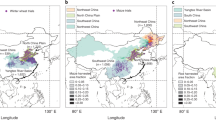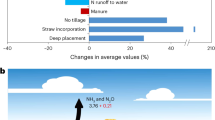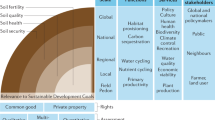Abstract
Soil health affects both food production and environmental quality. However, quantifying its impact poses a substantial global challenge due to the scarcity of comprehensive soil health data and the complexity of disentangling its effects from other variables. Here we integrate high-resolution global data on soil, climate and farm management practices to assess the contribution of soil health to agricultural productivity. We show that soil health is responsible for approximately 12% and 22% of global variations in crop production and nitrogen use efficiency, respectively. While the influence of climate on crop yields is comparable to that of soil health, it is substantially overshadowed by the role of agricultural management, which accounts for roughly 70% of the global yield variation. In regions such as China, India and the central United States, the influence of soil health on crop yields and nitrogen use efficiency is less pronounced due to the dominant effects of farming practices, including the intensive use of fertilizers. Enhancing global soil health could increase crop yields by 7.8 Mt while reducing nitrogen surplus by 8.1 Mt worldwide by 2050. It is crucial to achieve global sustainable development through managing soil health beyond traditional agricultural practices and climate adaptation.
This is a preview of subscription content, access via your institution
Access options
Access Nature and 54 other Nature Portfolio journals
Get Nature+, our best-value online-access subscription
27,99 € / 30 days
cancel any time
Subscribe to this journal
Receive 12 digital issues and online access to articles
118,99 € per year
only 9,92 € per issue
Buy this article
- Purchase on SpringerLink
- Instant access to full article PDF
Prices may be subject to local taxes which are calculated during checkout





Similar content being viewed by others
Data availability
We utilized nitrogen budget data at a 0.5° × 0.5° spatial resolution, including fertilizer input, biological nitrogen fixation, deposition and manure, from the IMAGE–GNM database (https://doi.org/10.5194/gmd-8-4045-2015)28. Cropland data, measured in square kilometres per grid at the same resolution, were obtained from HYDE v. 3.2 (https://doi.org/10.5194/essd-9-927-2017)29. Rural population data were sourced from the WorldPop dataset (https://www.worldpop.org/)30. Soil physical properties, including bulk density, pH and organic carbon density, were extracted from the surface layer (0–30 cm) at a 1 km × 1 km resolution (ISRIC dataset; https://files.isric.org/). Phosphorus content was sourced from figshare (https://doi.org/10.6084/m9.figshare.14583375)50. Biotic data were from ref. 51, covering fungal richness data from ref. 52, bacterial richness data from ref. 20, viral abundance data from ref. 53, and nematode and worm abundance data from ref. 54. Soil pesticide data, including fungicides, herbicides and insecticides, were sourced from ref. 55. Climate data for 2020, including temperature and precipitation at a 0.5° × 0.5° resolution, were obtained from CRU TS v. 4.06 (https://doi.org/10.1038/s41597-020-0453-3)34. For scenario analysis, we collected cropland area, population, temperature and precipitation data under three SSP–RCP scenarios (SSP1–RCP2.6, SSP2–RCP4.5 and SSP5–RCP8.5). Cropland area projections until 2050 were sourced from the LUH2 dataset (https://luh.umd.edu/data.shtml). Population projections until 2050 were obtained from gridded datasets for population and economy under SSPs (https://doi.org/10.57760/sciencedb.01683)36. Monthly temperature and precipitation data (2015–2050) at 0.9° × 1.25° resolution were sourced from CMIP6 (https://esgf-node.llnl.gov/projects/cmip6/). Data supporting this study’s findings are included in the article and Supplementary Information. Additional data are sourced from publicly available databases and literature, as cited in the reference list. Source data are provided with this paper.
Code availability
Statistical analyses and computations were conducted using Stata 16.0. All model code is available in the Supplementary Information.
References
Zhang, X. et al. Managing nitrogen for sustainable development. Nature 528, 51–59 (2015).
Steffen, W. et al. Planetary boundaries: guiding human development on a changing planet. Science 347, 1259855 (2015).
Stevens, C. J. Nitrogen in the environment: excess nitrogen causes problems in developed nations, but nitrogen-poor soils threaten food security elsewhere. Science 363, 578–580 (2019).
Ren, C. et al. Climate change unequally affects nitrogen use and losses in global croplands. Nat. Food 4, 294–304 (2023).
Ju, X. T. et al. Reducing environmental risk by improving N management in intensive Chinese agricultural systems. Proc. Natl Acad. Sci. USA 106, 3041–3046 (2009).
Larkin, R. P. Soil health paradigms and implications for disease management. Annu. Rev. Phytopathol. 53, 199–221 (2015).
Ma, B. et al. A genomic catalogue of soil microbiomes boosts mining of biodiversity and genetic resources. Nat. Commun. 14, 7318 (2023).
Bünemann, E. K. et al. Soil quality – a critical review. Soil Boil. Biochem. 120, 105–125 (2018).
McBratney, A., Field, D. J. & Koch, A. The dimensions of soil security. Geoderma 213, 203–213 (2014).
Dunbabin, V. M. et al. Modelling root–soil interactions using three-dimensional models of root growth, architecture and function. Plant Soil 372, 93–124 (2013).
Moraes, M. T. D. et al. Soil compaction impacts soybean root growth in an Oxisol from subtropical Brazil. Soil Tillage Res. 200, 104611 (2020).
Shakoor, A. et al. Effect of animal manure, crop type, climate zone, and soil attributes on greenhouse gas emissions from agricultural soils—a global meta-analysis. J. Clean. Prod. 278, 124019 (2021).
Salim, N. & Raza, A. Nutrient use efficiency (NUE) for sustainable wheat production: a review. J. Plant Nutr. 43, 297–315 (2020).
Bertrand, M. et al. Earthworm services for cropping systems. A review. Agron. Sustain. Dev. 35, 553–567 (2015).
Sinha, E., Michalak, A. M. & Balaji, V. Eutrophication will increase during the 21st century as a result of precipitation changes. Science 357, 405–408 (2017).
Ren, C. et al. Fertilizer overuse in Chinese smallholders due to lack of fixed inputs. J. Environ. Manag. 293, 112913 (2021).
Ren, C. et al. Ageing threatens sustainability of smallholder farming in China. Nature 616, 96–103 (2023).
Erisman, J. W., Sutton, M. A., Galloway, J., Klimont, Z. & Winiwarter, W. How a century of ammonia synthesis changed the world. Nat. Geosci. 1, 636–639 (2008).
van Groenigen, J. W. et al. Earthworms increase plant production: a meta-analysis. Sci. Rep. 4, 6365 (2014).
Ma, B. et al. Biogeographic patterns and drivers of soil viromes. Nat. Ecol. Evol. 8, 717–728 (2024).
Romero, F. et al. Soil health is associated with higher primary productivity across Europe. Nat. Ecol. Evol. 8, 1847–1855 (2024).
Guo, X., Liu, H. & Zhang, J. The role of biochar in organic waste composting and soil improvement: a review. Waste Manag. 102, 884–899 (2020).
Amelung, W. et al. Towards a global-scale soil climate mitigation strategy. Nat. Commun. 11, 5427 (2020).
Campanhola, C. & Pandey, S. (eds) Sustainable Food and Agriculture (Academic Press, 2019).
Gu, B. et al. Abating ammonia is more cost-effective than nitrogen oxides for mitigating PM2.5 air pollution. Science 374, 758–762 (2021).
Gu, B. et al. Cost-effective mitigation of nitrogen pollution from global croplands. Nature 613, 77–84 (2023).
Brink, C. et al. in The European Nitrogen Assessment: Sources, Effects and Policy Perspectives (eds Sutton, M. A. et al.) 513–540 (Cambridge Univ. Press, 2011).
Beusen, A. H. W., Van Beek, L. P. H., Bouwman, A. F., Mogollón, J. M. & Middelburg, J. J. Coupling global models for hydrology and nutrient loading to simulate nitrogen and phosphorus retention in surface water – description of IMAGE–GNM and analysis of performance. Geosci. Model Dev. 8, 4045–4067 (2015).
Klein Goldewijk, K., Beusen, A., Doelman, J. & Stehfest, E. Anthropogenic land use estimates for the Holocene – HYDE 3.2. Earth Syst. Sci. Data 9, 927–953 (2017).
WorldPop Dataset (WorldPop, 2020); https://www.worldpop.org/
Zhu, P. et al. Warming reduces global agricultural production by decreasing cropping frequency and yields. Nat. Clim. Change 12, 1016–1023 (2022).
Agnolucci, P. et al. Impacts of rising temperatures and farm management practices on global yields of 18 crops. Nat. Food 1, 562–571 (2020).
Ortiz-Bobea, A., Ault, T. R., Carrillo, C. M., Chambers, R. G. & Lobell, D. B. Anthropogenic climate change has slowed global agricultural productivity growth. Nat. Clim. Change 11, 306–312 (2021).
Harris, I., Osborn, T. J., Jones, P. & Lister, D. Version 4 of the CRU TS monthly high-resolution gridded multivariate climate dataset. Sci. Data 7, 109 (2020).
Ma, L. et al. Global rules for translating land-use change (LUH2) to land-cover change for CMIP6 using GLM2. Geosci. Model Dev. 13, 3203–3220 (2020).
Jiang, T., Su, B. & Wang, Y. National and provincial population and economy projection databases under Shared Socioeconomic Pathways (SSP1–5)_v2. Science Data Bank https://doi.org/10.57760/sciencedb.01683 (2024).
Swart, N. C. et al. Amon_CanESM5 _r1i1p1f1: CMIP6 Monthly Data for Surface Air Temperature and Precipitation (Canadian Centre for Climate Modelling and Analysis, accessed 15 October 2023); https://aims2.llnl.gov/search
Gu, B., Ju, X., Chang, J., Ge, Y. & Vitousek, P. M. Integrated reactive nitrogen budgets and future trends in China. Proc. Natl Acad. Sci. USA 112, 8792–8797 (2015).
Zalasiewicz, J., Williams, M., Steffen, W. & Crutzen, P. The new world of the Anthropocene. Environ. Sci. Technol. 44, 2228–2231 (2010).
Lesk, C. et al. Stronger temperature–moisture couplings exacerbate the impact of climate warming on global crop yields. Nat. Food 2, 683–691 (2021).
He, L. & Rosa, L. Solutions to agricultural green water scarcity under climate change. PNAS Nexus 2, pgad117 (2023).
Wang, X. et al. Global irrigation contribution to wheat and maize yield. Nat. Commun. 12, 1235 (2021).
Klimont, Z. & Winiwarter, W. Integrated Ammonia Abatement—Modelling of Emission Control Potentials and Costs in GAINS. IIASA Interim Report IR-11-027 (IIASA, 2011).
Beach, R. H. et al. Global mitigation potential and costs of reducing agricultural non-CO2 greenhouse gas emissions through 2030. J. Integr. Environ. Sci. 12, 87–105 (2015).
Sobota, D. J. et al. Cost of reactive nitrogen release from human activities to the environment in the United States. Environ. Res. Lett. 10, 025006 (2015).
Giannadaki, D., Giannakis, E., Pozzer, A. & Lelieveld, J. Estimating health and economic benefits of reductions in air pollution from agriculture. Sci. Total Environ. 622–623, 1304–1316 (2018).
Chen, Q. et al. Research on the evaluation method of the ecosystem services of Earth’s critical zone. J. Nanjing Univ. Nat. Sci. 58, 1070–1086 (2022).
Yue, D., Wang, L., Geng, R., Wang, Q. & Dai, Y. Initial assessment of seaweed farming ecological value in coastal waters of China. J. Agric. Sci. Technol. 16, 126–133 (2014).
Strefler, J. et al. Alternative carbon price trajectories can avoid excessive carbon removal. Nat. Commun. 12, 2264 (2021).
He, X. et al. A global dataset of soil total phosphorus concentration in (semi-)natural terrestrial ecosystems. figshare https://doi.org/10.6084/m9.figshare.14583375.v9 (2021).
Tedersoo, L. et al. Global diversity and geography of soil fungi. Science 346, 1256688 (2014).
Delgado-Baquerizo, M. et al. A global atlas of the dominant bacteria found in soil. Science 359, 320–325 (2018).
van den Hoogen, J. et al. Soil nematode abundance and functional group composition at a global scale. Nature 572, 194–198 (2019).
Phillips, H. R. P. et al. Global distribution of earthworm diversity. Science 366, 480–485 (2019).
Tang, F. H. M. et al. Risk of pesticide pollution at the global scale. Nat. Geosci. 14, 206–210 (2021).
Acknowledgements
This study was supported by the National Natural Science Foundation of China (42325707 and 42261144001) and National Key Research and Development Project of China (2022YFE0138200).
Author information
Authors and Affiliations
Contributions
B.G. and J.X. designed the study. C.R., X.Z. and C.W. conducted the research and analysed the data. B.G. interpreted the findings and wrote the first draft of the paper. B.M., Y.H., L.H., X.L., S.W., F.Z., L.L. and S.L. provided support for the data availability and processed the raw data. J.Z., Y.-G.Z. and P.V. revised the paper. All authors contributed to the discussion and revision of the paper.
Corresponding authors
Ethics declarations
Competing interests
The authors declare no competing interests.
Peer review
Peer review information
Nature Food thanks Hai-Lin Zhang and the other, anonymous, reviewer(s) for their contribution to the peer review of this work.
Additional information
Publisher’s note Springer Nature remains neutral with regard to jurisdictional claims in published maps and institutional affiliations.
Supplementary information
Supplementary Information
Supplementary Methods, Tables 1–16, Figs. 1–34 and text.
Source data
Source Data Fig. 1
Source data for generating Fig. 1.
Source Data Fig. 3
Source data for generating Fig. 3.
Source Data Fig. 4
Source data for generating Fig. 4.
Source Data Fig. 5
Source data for generating Fig. 5.
Rights and permissions
Springer Nature or its licensor (e.g. a society or other partner) holds exclusive rights to this article under a publishing agreement with the author(s) or other rightsholder(s); author self-archiving of the accepted manuscript version of this article is solely governed by the terms of such publishing agreement and applicable law.
About this article
Cite this article
Xu, J., Ren, C., Zhang, X. et al. Soil health contributes to variations in crop production and nitrogen use efficiency. Nat Food 6, 597–609 (2025). https://doi.org/10.1038/s43016-025-01155-6
Received:
Accepted:
Published:
Issue Date:
DOI: https://doi.org/10.1038/s43016-025-01155-6
This article is cited by
-
Managing soil health for resilient crop production
Nature Food (2025)



